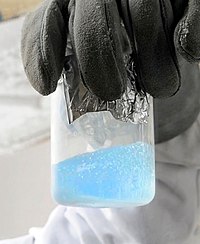
Photo from wikipedia
Abstract Hydrate carbon dioxide (CO2) separation is a promising method for reducing carbon emission. In this work, water-solubility of tetrahydrofuran (THF) was added into water to generate the single gas/liquid… Click to show full abstract
Abstract Hydrate carbon dioxide (CO2) separation is a promising method for reducing carbon emission. In this work, water-solubility of tetrahydrofuran (THF) was added into water to generate the single gas/liquid interface. In order to understand hydrate nucleation and crystallization well, CO2 concentration in the residual gaseous phase was measured, morphology of the hydrate formation was filmed, and structure changes of compounds around the gas/liquid interface was monitored by in situ Raman spectrometer. Two groups of experiments were carried out at 274.15 K and 4.0 MPa in the systems with and without gas supply. The experimental results illustrate that hydrate formation is completed in 5 h according to CO2 concentration, gas consumption and morphology, however, the compound transition and hydrate crystallization are still in process from the microstructure point of view. For the system with gas supply, the hydrates initially occur in the gas/liquid interface due to stable gas flux in the boundray layer, where Raman spectra change regularly at the beginning. Such stable gas flux has a positive impact on changing water aggregation. This change of water aggregation benefits for the original structures in the process of hydrate nucleation. With the hydrate formation, the hydrate nucleation interface is moving from the gas/liquid interface towards the THF solution. Otherwise, for the system without gas supply, no obvious hydrate was observed in the gas/liquid interface, and Raman spectra around the interface change with the saltation from gaseous phase towards the THF solution. For the two systems, THF hydrates form prior to the multi-hydrates and keep forming, and both intensity of Raman peaks around the interfaces is the weakest.
Journal Title: Applied Energy
Year Published: 2018
Link to full text (if available)
Share on Social Media: Sign Up to like & get
recommendations!